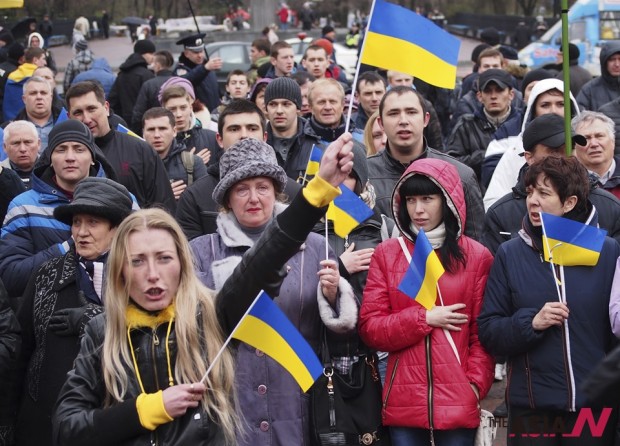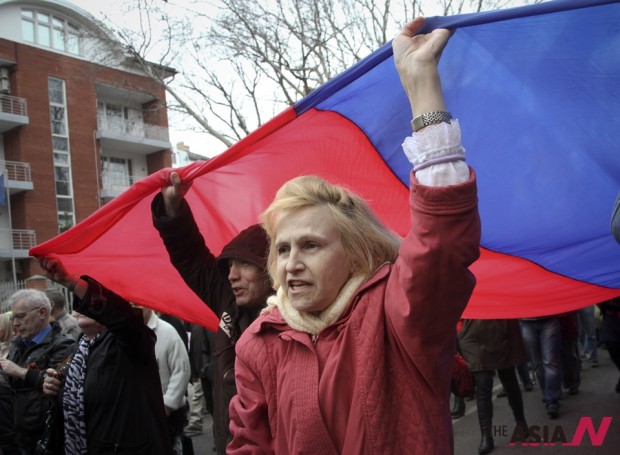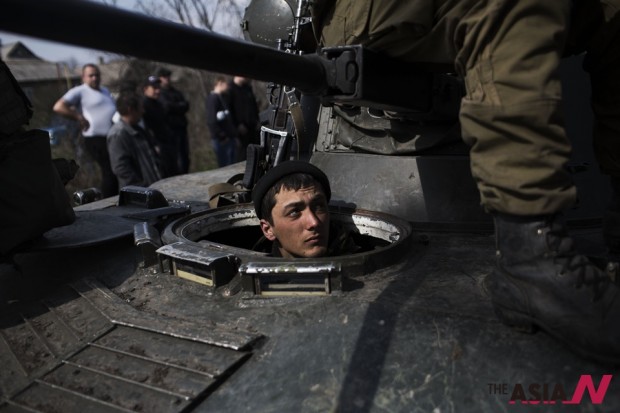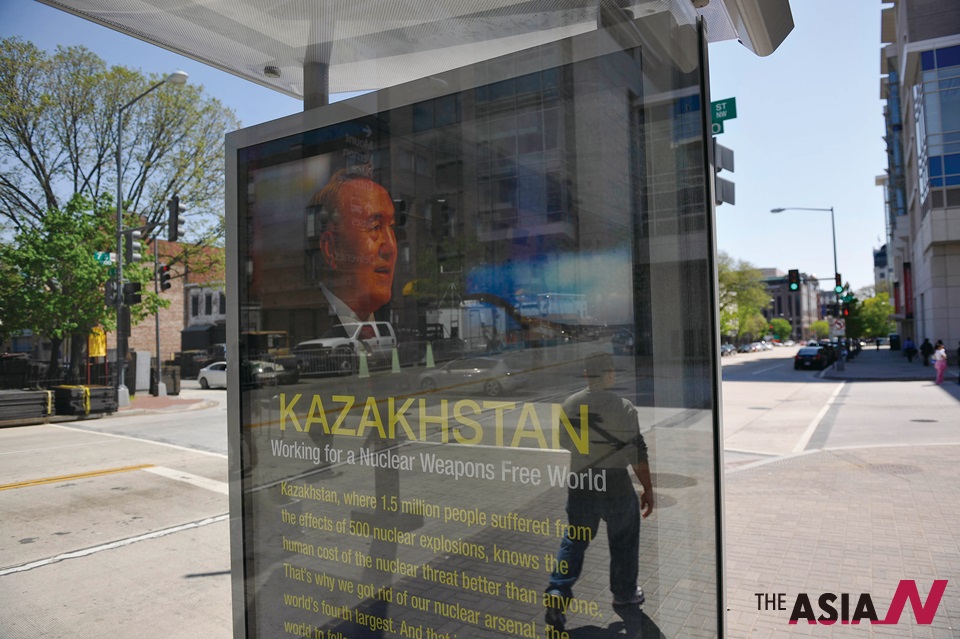
Ukraine and new tensions in the world

Developments in Ukraine, which began in November 2013, shocked the world. That shock was not because the people revolted against the government and demanded changes, but because it was causing change to the world order, which remained as such for many decades. Divided by political priorities, the modern world has two camps that oppose each other. Despite the fact that the era of the Cold War ended a long time ago, the gradually increasing power of Russia has led to an escalation of tensions in the world. Meanwhile, Russia is not taking into consideration the fact that the economic potential of the country is not well developed and is mainly focused on the export of raw materials. Russia is rich in raw materials in contrast to most countries. The main raw materials, which are in great demand by the world, as in the Soviet era, are oil and gas. The volume of crude oil per year is nearly 520 million tons, and gas about 650 billion cubic meters. At the moment, Russia’s GDP is 2.014 trillion dollars and its economy makes up 4.1 per cent of the world economy. The export of oil is almost 35 per cent, and gas 15 per cent of Russia’s total exports. According to the 2012 data, exports to Ukraine from Russia were equal to $45 billion, and a significant part of it was the gas supply.
In 1991, with a view to the final collapse of the Soviet Union, leaders of the three Slavic republics – Russia, Ukraine and Belarus – signed an agreement on the dissolution of the Soviet power and creation of a Commonwealth of Independent States – CIS. Even then, Ukraine had declared its independent policy in relation to the new political association. That is why in many documents signed by members of the Commonwealth, the Ukrainian signature has a different reservation. After Vladimir Putin came to power, Russia’s relations with Ukraine have become more stringent. An attempt of Moscow to draw Kiev into its orbit when it started to create a customs union, which was agreed upon by Russia, Kazakhstan and Belarus, was not successful. Since then, Russian and Ukrainian ties, mainly economic and political relations, have become more complicated. After the Orange Revolution in 2004, when the opposition, which had a clear political orientation to the West, came to power in Ukraine, the relationship grew worse. Meanwhile, Ukraine divided itself into eastern and western parts both geographically and mentally. Some parts of western Ukraine were annexed by the Soviet Union in 1939 and joined with Ukraine according to the agreement with Germany at the time. However, the results of the Second World War did not lead to the unity of the two parts of Ukraine and communist propaganda pushed the most conservative part of western Ukraine away from Russia. Residents of the western regions of the country have always looked to their Western neighbors. But, the economy of western Ukraine began to develop only in the Soviet era. The Soviets had developed the agricultural industry of the country. For instance, L’viv city on the border with Poland had no industry until a plant to produce cars was built under the Soviets. However, the mentality of western region population has not perceived Russia as an ally, but as an occupier.

Sevastopol at issue
Unlike in the western region, eastern Ukraine has a well-developed industry. It is home to a significant portion of the population that has been loyal to Russia since the days of Imperial Russia. The working class has always been active, and most of the population speaks Russian. The ethnic Russian population of Ukraine is 8 million, most of who live in the Kharkiv, Donetsk and Luhansk regions. The population of the Crimea peninsula, which was granted to Ukraine by the Soviet ruler Nikita Khrushchev in 1954, is about 2 million people and 60 per cent of them are Russian.
Many in the world do not realize how the two very close nations were divided and became a part of the two different political camps. The current situation was formed long before and Ukrainian nationalists would never agree to remain under the influence of Russians, who were called “Katsap” and “Muscovites,” while Russian called Ukrainians “tufts.” Having gained independence from Moscow, all new heads of sovereign of Ukraine tried to move away from possible Russia influence. However, they were busier with politics than with economics, making Ukraine far behind in development. With a population of 45 million, Ukraine fell into the hands of oligarchs who enriched themselves at the expense of the masses. The Crimean example is indicative in this respect. With great opportunities to attract foreign tourists to the shores of the Black Sea, Crimea failed to create the necessary conditions, which led to a decrease in the flow of tourists. The peninsula was a place to visit for locals and Russian visitors as services for tourists were far behind.
At issue is Sevastopol city, which is one of the most important reasons behind the annexation of Crimea by Russia. Sevastopol is the naval port, where the Black Sea Navy of Russia is based. Only a small part of the port has been assigned to the Ukrainian Navy. However, according to the Treaty on the division of property of the USSR from 1992, the city of Sevastopol belonged to Ukraine and the naval base was transferred to Russia for lease. First, the two sides signed a lease until 2008, which was then extended by President of Ukraine Yanukovich till 2017. In 2012, this agreement was extended until 2042. Russia paid Ukraine a lot of money annually for the rent of the naval base in Sevastopol. The main forces of the Russian Black Sea Fleet are located in Sevastopol, and Ukraine from the outset sought to expel the Russian Navy from the base. On this basis, relations between Moscow and Kiev have also been worsening. Relations between Ukraine and Russia reached a bottom at the time of President Yushchenko. Having pipelines on its territory, through which Russian gas flows to Europe, in 2009, the Ukrainian company “Naftogaz” used gas directed to the Eastern European countries without permission, which caused an acute shortage of gas in the winter in several countries in Europe. After tough negotiations, through the mediation of Germany and other European countries, Ukraine paid its debt and pledged not to take gas without paying. Once a new contract for the supply of gas to Ukraine was signed at new prices, the supply resumed. However, this incident had already shown the nature of the economic relations between the two countries.
In November 2013, the then pro-Russian President Viktor Yanukovych publicly refused to sign an Association Agreement with the European Union in Lithuania. Consequently, barricades of tires appeared in the center of Kiev. Several opposition groups organized a protest. The opposition groups demanded rapprochement with the EU. Some of them saw a way out of the economic crisis in the rapprochement with the West. As a result of the three-month standoff, the protestors demanded the resignation of the government. Several neighboring countries’ officials have visited Kiev, as well as representatives from the United States. Such an open support of Western countries united disparate political forces in the country. Among them were also ardent Ukrainian nationalists who openly began to call for the overthrow of the government, which was considered more pro-Russian. After provocations at Maidan, the main square of Kiev, clashes between police and protesters took place. As a result, more than 100 people were killed on both sides; 18 of them were from the police. On February 21, 2014, foreign ministers of Germany, France and Poland, who have become mediators of negotiations between the opposition and President Yanukovych, arrived in Kiev. On the same day, an agreement was reached on the establishment of a coalition government and a call for early presidential elections in December 2014. By a strange coincidence, after this historic event, there was an attempt to kill President Yanukovych, on which he immediately fled first to his birthplace Dnipropetrovsk, and then to the Russian city of Rostov-on-Don, where he is still staying. Thereafter, the re-formatted parliament of Ukraine has announced the appointment of a new Speaker of Parliament and the appointment of the new Government of Ukraine. It was also announced that the presidential elections would be held on May 24 this year.

Russia and West at loggerheads
Due to the growing influence of nationalist forces who came to power in Kiev, many regions of Ukraine feared reprisals and put forward an idea for the federalization of the country, which may limit the influence of the new government in the regions. The first step in this regard was making the Crimean Autonomous Republic. Its active residents did not allow Crimea emissaries from Kiev to come to power, and its residents decided to call a referendum to join Russia through its local parliament, Verkhovna Rada. It was held on March 16, 2014.
Taking advantage of this, Russia introduced “unidentified” troops into the region and blocked any interference in the internal process of Kiev on the peninsula. As a result, the vast majority of voters voted in favor of joining Russia. Legitimacy of the decision of the Crimean population is challenged by the authorities of Ukraine and Western countries. Declaring incompetence based on the outcome of the referendum, which took place without the consent of Kiev and contrary to the Constitution of Ukraine, the Western countries and the United States announced sanctions against Russia. However, given the diversity of their relations with Russia, the big question is whether the sanctions could be effective. Ready for such steps of the West and the U.S., Russia made threats that they could respond.
Meanwhile, the eastern parts of Ukraine, whose inhabitants are frightened of new authorities in Kiev, requested a referendum on federalization of the country, on which Moscowinsists. However, Kievand the West do not want this and that is why negotiation son Ukraine between Russian Foreign Minister Sergei Lavrov and U.S. Secretary of State John Kerry, which took place in Paris recently, have not yet yielded results. In response to this,the Donetsk region has now declared its independence from Kievand requires conduct similar to the Crimean referendum on joining Russia. There is an opinion that Russia may be playing a role behind present events in eastern Ukraine. Despite the mixed and mostly negative reaction of the international community, Russia has decided to start a new round of confrontation with the Western world. And it is very difficult to predict where this conflict might lead the world.



